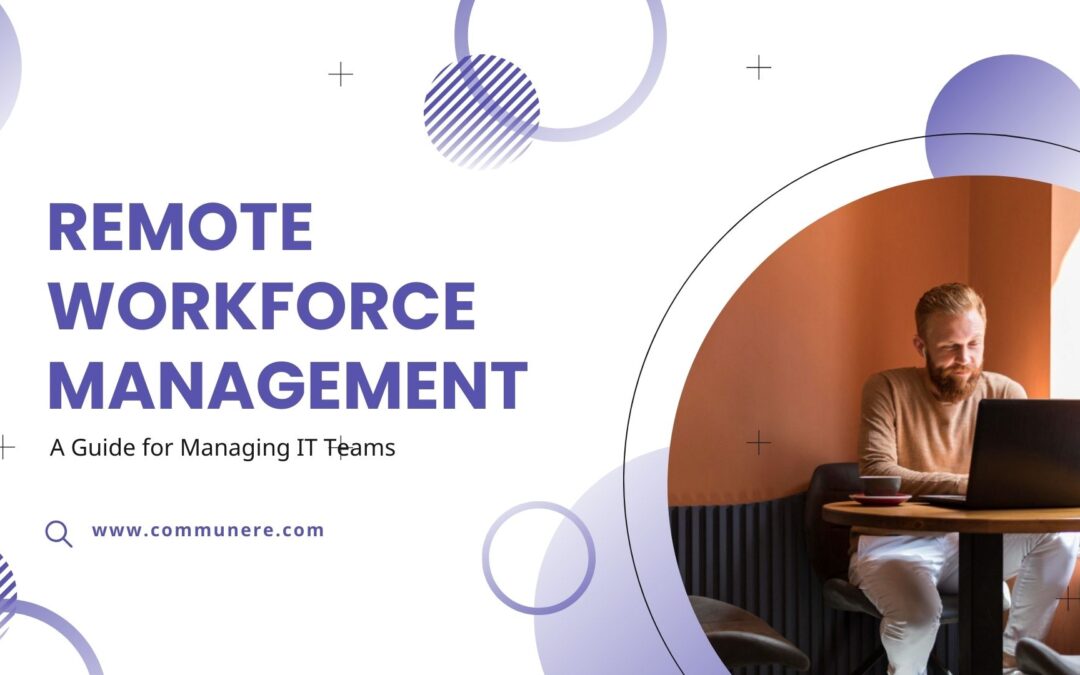In the ever-evolving landscape of the technology sector, the rise of remote work has emerged as a defining feature of the modern workplace, particularly within IT teams. The year 2024 has ushered in an era where geographical boundaries are increasingly irrelevant in the realms of technical recruitment and team collaboration. This shift towards a remote workforce, while laden with opportunities, presents a unique set of challenges and demands a rethinking of traditional management practices.
Understanding how to manage a remote IT team effectively is critical for maintaining productivity, fostering innovation, and ensuring a harmonious work environment. This guide is tailored to address the specific needs and hurdles faced by managers of remote IT teams. We will explore strategies for effective communication, collaboration, performance management, and more, ensuring that your team not only adapts to but thrives in this remote work era.
This blog post will cover a spectrum of topics, from the utilisation of cutting-edge tools and technologies to the fostering of a positive and productive remote work culture. Whether you’re transitioning an existing team to a remote model or building a remote IT team from the ground up, this guide aims to provide you with actionable insights and best practices to navigate the complexities of remote workforce management in 2024.
Table of Contents
- Adapting to the Remote Work Environment
- Communication and Collaboration Strategies
- Performance Management in a Remote Setting
- Cybersecurity and Data Protection
- Fostering Team Engagement and Morale
- Navigating Time Zone Differences and Scheduling
- Remote Work Policies and Legal Considerations
- AI and Automation in Remote Workforce Management for IT Teams
- Remote Workforce Management: A Recap
- Additional Resources on Remote Workforce Management
Adapting to the Remote Work Environment
It’s crucial to acknowledge that managing IT teams remotely is a distinct experience, replete with its own set of challenges and opportunities. It is vital to approach these challenges and tools with an open mind. Understanding that each team and individual may have different needs and preferences is key to creating a successful and adaptable remote working model. The goal is to leverage technology not just as a substitute for the traditional office, but as a platform to enhance and streamline the IT team’s operations, fostering a more dynamic, flexible, and inclusive work environment.
Understanding the Challenges of Remote IT Work
- Communication Barriers: Without face-to-face interaction, conveying complex technical concepts and maintaining clarity can be more challenging.
- Remote Collaboration: Coordinating tasks and projects among team members who are distributed across various locations requires a different approach.
- Isolation and Work-Life Balance: Remote workers often struggle with feeling isolated and managing the boundaries between work and personal life.
Essential Tools and Tech for Remote IT Teams
- Collaboration Platforms: An exploration of the latest collaboration tools that facilitate seamless communication and project management.
- Virtual Office Environments: How virtual reality and augmented reality are creating immersive workspaces for remote teams.
- Cloud-Based Solutions: Emphasising the importance of cloud technology for accessible, secure, and efficient work processes.
Creating a Conducive Remote Work Culture
- Establishing Trust and Autonomy: Strategies for building trust within the team and empowering employees with autonomy in their work.
- Regular Check-ins and Virtual Meetings: Balancing the frequency of meetings to stay connected without causing ‘Zoom fatigue’.
- Encouraging Work-Life Balance: Initiatives and policies to help team members manage their time effectively and maintain a healthy work-life balance.
Communication and Collaboration Strategies
Effective communication and collaboration are the bedrock of any successful remote IT team. It’s about creating a transparent, inclusive, and responsive communication environment that not only addresses the challenges of remote work but also harnesses its potential to bring out the best in each team member.
In this section, we’ll explore how to optimise these elements in a remote work setting.
Best Practices for Maintaining Clear and Consistent Communication
- Structured Communication Protocols: Establishing clear protocols for how and when to communicate, including the use of email, instant messaging, and video calls.
- Regular Team Meetings and One-on-Ones: Scheduling regular team meetings and individual check-ins to ensure alignment and address any concerns.
- Effective Use of Communication Tools: Training the team on the effective use of communication tools to avoid miscommunications and ensure efficient exchange of information.
Tools and Platforms for Effective Collaboration
- Collaboration Tools Overview: An examination of the leading collaboration tools in 2024, focusing on their features, benefits, and suitability for different types of IT tasks.
- Integrating Tools into Daily Workflows: Strategies for seamlessly integrating these tools into the team’s daily workflows to maximise their utility.
- Customising Tools for Specific Team Needs: Tailoring these tools to fit the unique needs of your team, including custom integrations and add-ons.
Overcoming Common Communication Barriers in Remote Teams
- Addressing Technological Challenges: Ensuring all team members have access to and are proficient in the necessary technologies.
- Cultural and Language Differences: Strategies for bridging cultural and language barriers in globally distributed teams.
- Ensuring Inclusivity in Communication: Fostering an inclusive environment where every team member feels heard and valued.
Performance Management in a Remote Setting
Effective performance management in a remote setting is not just about tracking productivity; it’s about nurturing a culture of continuous improvement, open communication, and support. By setting clear expectations, regularly reviewing goals, and providing constructive feedback and support, managers can help their remote IT teams achieve their full potential. This approach ensures that performance management is a collaborative and ongoing process, contributing positively to both individual and team growth.
This section explores how to effectively manage and enhance team performance from a distance.
Setting Clear Expectations and Goals
- Defining Clear Objectives: Establishing well-defined, measurable goals that align with the team’s and organisation’s objectives.
- Creating Transparent Metrics: Developing clear metrics for performance evaluation that are understood and agreed upon by all team members.
- Regular Goal Reviews: Implementing regular review sessions to assess progress and adjust goals as needed.
Monitoring and Evaluating Performance Remotely
- Performance Tracking Tools: Utilising tools and software designed for tracking and reporting on team and individual performance.
- Balancing Autonomy and Oversight: Finding the right balance between giving team members autonomy and ensuring accountability.
- Feedback and Recognition: The importance of timely and constructive feedback, as well as recognising and celebrating achievements in a remote setting.
Providing Feedback and Support to Remote Employees
- Constructive Feedback Techniques: How to provide feedback in a way that is constructive, supportive, and conducive to growth.
- Professional Development Opportunities: Encouraging continuous learning and offering opportunities for skill enhancement and career growth.
- Mental Health and Wellbeing Support: Recognising the unique stressors of remote work and providing support for mental health and overall wellbeing.
Cybersecurity and Data Protection
In a remote IT work environment, cybersecurity and data protection take on an even greater significance.
It’s not only about implementing cutting-edge security tools and protocols but also cultivating a culture of security awareness and vigilance among all team members. Regular training, combined with a proactive approach to security, ensures that the team is well-equipped to handle the unique challenges of maintaining cybersecurity in a remote work environment.
This section delves into the strategies and practices necessary to safeguard sensitive information and maintain robust security protocols.
A. Importance of Cybersecurity in Remote IT Work
- Risks and Vulnerabilities: Understanding the increased risks and vulnerabilities associated with remote work, including potential threats and attack vectors.
- Data Privacy Considerations: The significance of data privacy in a remote setting, especially when handling client or customer information.
- Compliance with Regulations: Staying abreast of and complying with relevant cybersecurity regulations and standards.
B. Implementing Robust Security Protocols and Tools
- Secure Network Connections: The necessity of secure connections, including the use of VPNs and encrypted networks.
- Endpoint Security Measures: Ensuring all devices used by team members are secure and have up-to-date anti-malware and security software.
- Regular Security Audits and Updates: Conducting regular security audits and ensuring all systems and software are updated to protect against the latest threats.
C. Training Team Members on Security Best Practices
- Developing a Security-Minded Culture: Fostering a culture where cybersecurity is a priority for every team member.
- Regular Training Sessions: Organising ongoing cybersecurity training sessions to keep the team informed about new threats and best practices.
- Phishing and Scam Awareness: Educating the team on recognising and responding to phishing attempts and other common scams.
Fostering Team Engagement and Morale
Maintaining high levels of engagement and morale is vital for the success of remote IT teams. Fostering team engagement and morale in a remote environment requires thoughtful and ongoing efforts. By creating opportunities for social interaction, recognising achievements, and supporting team members’ wellbeing, managers can build a positive and productive remote work culture. Such an environment not only enhances team performance but also contributes to each individual’s personal and professional growth.
This section focuses on strategies to build a positive and cohesive team environment, even when members are physically apart.
Strategies for Building Team Cohesion Remotely
- Regular Social Interactions: Implementing virtual coffee breaks or casual catch-ups to foster informal interactions among team members.
- Celebrating Milestones and Achievements: Recognising both individual and team achievements, and celebrating milestones to boost morale.
- Encouraging Collaboration and Peer Support: Facilitating opportunities for team members to collaborate on projects and support each other, enhancing team cohesion.
Organising Virtual Team-Building Activities
- Creative Online Team-Building Games: Exploring a variety of online games and activities designed for remote teams to engage in team-building.
- Virtual Workshops and Training Sessions: Conducting workshops or training sessions not only for professional development but also for team bonding.
- Interactive Challenges and Competitions: Hosting friendly challenges or competitions that can be done remotely to foster a sense of camaraderie and fun.
Addressing Remote Work Burnout and Isolation
- Recognising the Signs of Burnout: Understanding the signs of burnout in remote workers and taking proactive steps to address it.
- Promoting a Healthy Work-Life Balance: Encouraging practices and policies that help employees maintain a healthy balance between work and personal life.
- Providing Mental Health Support: Offering resources and support for mental health, including access to counselling services or wellness programmes.
Effective management of remote IT teams often involves dealing with the complexities of time zone differences. By adopting a mix of synchronous and asynchronous work practices and respecting individual schedules, teams can ensure efficiency without compromising work-life balance. This approach also encourages a more inclusive and considerate work environment, where the diversity of global team members is seen as an asset rather than a challenge.
This section offers strategies for scheduling and coordination that respect the diverse locations of team members.
Managing Teams Across Multiple Time Zones
- Time Zone Awareness: Understanding and being mindful of the time zones in which team members are located.
- Centralised Scheduling Tools: Utilising tools that help visualise and manage the team’s schedules across different time zones.
- Rotating Meeting Times: Implementing a fair rotation of meeting times to accommodate different time zones without overly burdening any single group.
Flexible Scheduling Strategies
- Core Hours Concept: Establishing core hours where everyone is available, while allowing for flexibility outside these hours.
- Asynchronous Communication: Emphasising asynchronous communication methods to mitigate the need for real-time interaction.
- Individualised Work Schedules: Allowing team members to work during hours that best suit their productivity and personal circumstances.
Balancing Synchronous and Asynchronous Work
- Determining Work Types: Deciding which tasks require synchronous collaboration and which can be done asynchronously.
- Effective Use of Asynchronous Tools: Maximising the use of tools like email, project management software, and collaborative documents for asynchronous work.
- Setting Clear Expectations: Clearly communicating when immediate responses are expected and when they are not, to avoid confusion and undue pressure.
Remote Work Policies and Legal Considerations
Developing comprehensive remote work policies and understanding the legal implications are crucial aspects of managing remote IT teams. Creating and maintaining clear, comprehensive remote work policies is essential for the smooth operation of remote IT teams. These policies not only provide a framework for expectations and responsibilities but also ensure legal compliance and protect both the organisation and its employees. Additionally, in an international context, these policies must be adaptable to accommodate various legal and cultural considerations, ensuring a fair and effective work environment for all team members.
This section explores how to create effective policies and navigate the legal landscape of remote work.
Developing Clear Remote Work Policies
- Defining Work Hours and Availability: Establishing guidelines on work hours, availability, and response times to ensure consistency and reliability.
- Home Office Requirements: Outlining the necessary home office setup, including ergonomic and safety standards.
- Data Security and Confidentiality: Implementing policies focused on data security, confidentiality, and the proper use of company resources.
Understanding Legal Implications of Remote Work
- Employment Laws and Regulations: Navigating the complexities of employment laws, which can vary significantly by region and country.
- Tax Implications: Understanding the tax implications for both the employer and employees, particularly when working across different jurisdictions.
- Contractual Obligations: Ensuring that employment contracts are updated to reflect the remote working arrangement and any specific terms related to it.
Adapting Policies to International Team Members
- Cultural Considerations: Acknowledging and respecting cultural differences in work practices and legal requirements.
- International Employment Laws: Being aware of and compliant with the employment laws in the countries where remote team members reside.
- Flexible Policy Framework: Creating a policy framework that is adaptable to cater to the diverse legal and cultural landscapes of an international team.
AI and Automation in Remote Workforce Management for IT Teams
Leveraging AI and automation in remote IT management not only streamlines operations but also opens up new possibilities for innovation and efficiency. By automating routine tasks, providing intelligent insights, and enhancing monitoring and reporting capabilities, these technologies allow IT teams to focus more on strategic and creative tasks. However, it is crucial to approach their implementation with consideration for ethical implications, data security, and the importance of maintaining human oversight.
This section discusses how AI and automation can be utilised to streamline processes and support remote IT teams.
A. Role of AI and Automation in Enhancing Productivity
- Automated Task Management: Utilising AI to automate routine tasks, such as scheduling, project tracking, and status updates.
- Intelligent Decision-Making Support: Implementing AI-driven tools that aid in making informed decisions based on data analysis and predictive insights.
- Enhanced Monitoring and Reporting: Using AI for continuous monitoring of systems and automated reporting, which helps in proactive problem-solving.
B. Tools and Platforms for Automating Routine Tasks
- AI-Powered Project Management Tools: Exploring tools that use AI to optimise project planning, resource allocation, and risk management.
- Chatbots and Virtual Assistants: Implementing chatbots and virtual assistants for handling routine inquiries and providing quick access to information.
- Automated Quality Assurance: Using AI for automated code reviews, testing, and quality assurance processes.
C. Ethical Considerations and Best Practices
- Data Privacy and Security: Ensuring that the use of AI and automation tools complies with data privacy laws and ethical standards.
- Transparency and Control: Maintaining transparency in how AI systems make decisions and ensuring human oversight and control.
- Bias and Fairness: Addressing potential biases in AI algorithms and striving for fairness in automated processes.
Remote Workforce Management: A Recap
To conclude our guide, let’s review the key insights and strategies that have been discussed.
Managing remote IT teams in this digital age requires a blend of technological savvy, adaptability, and a deep understanding of human dynamics.
The rise of remote work has presented unique challenges but also remarkable opportunities. Managers can enhance efficiency and foster a culture of innovation by embracing the right tools and technologies, from advanced communication platforms to AI and automation. However, the success of a remote team hinges not just on technology but on effective communication, clear performance management, robust cybersecurity measures, and the nurturing of team engagement and morale.
Dealing time zone differences, developing comprehensive remote work policies, and understanding the legalities of remote work are also critical in ensuring a smooth operation. As we move forward, the ability to adapt and continuously evolve these strategies will be key to thriving in the ever-changing landscape of IT management.
Remember that the essence of successful remote management lies in balancing technology with the human element. It’s about creating an environment where technology empowers and where every team member feels connected, engaged, and valued, regardless of their physical location.
Additional Resources on Remote Workforce Management
Books on Remote Workforce Management
- “Remote: Office Not Required” by Jason Fried and David Heinemeier Hansson offers insights into the foundations of remote work.
- “The Year Without Pants: WordPress.com and the Future of Work” by Scott Berkun explores remote work dynamics in a real-world context.
- “Distributed Teams: The Art and Practice of Working Together While Physically Apart” by John O’Duinn provides practical advice for managing distributed teams.
Online Tools
- Project Management: Asana, Trello, or Jira for task and project management.
- Communication: Slack and Microsoft Teams for team communication and collaboration.
- Time Zone Management: World Time Buddy or Every Time Zone for handling time zone differences.
Online Courses and Webinars
- Leadership and Management Courses: Platforms like Coursera, LinkedIn Learning, and Udemy offer remote team management and leadership courses.
- Webinars: Regularly attending webinars hosted by remote workforce and IT management experts can provide current insights and strategies.




![Why Custom Web Development is the Best Approach [2024]](https://resources.communere.com/wp-content/uploads/2024/02/Why-Custom-Web-Development-is-the-Best-Approach-1024x570.jpg)

